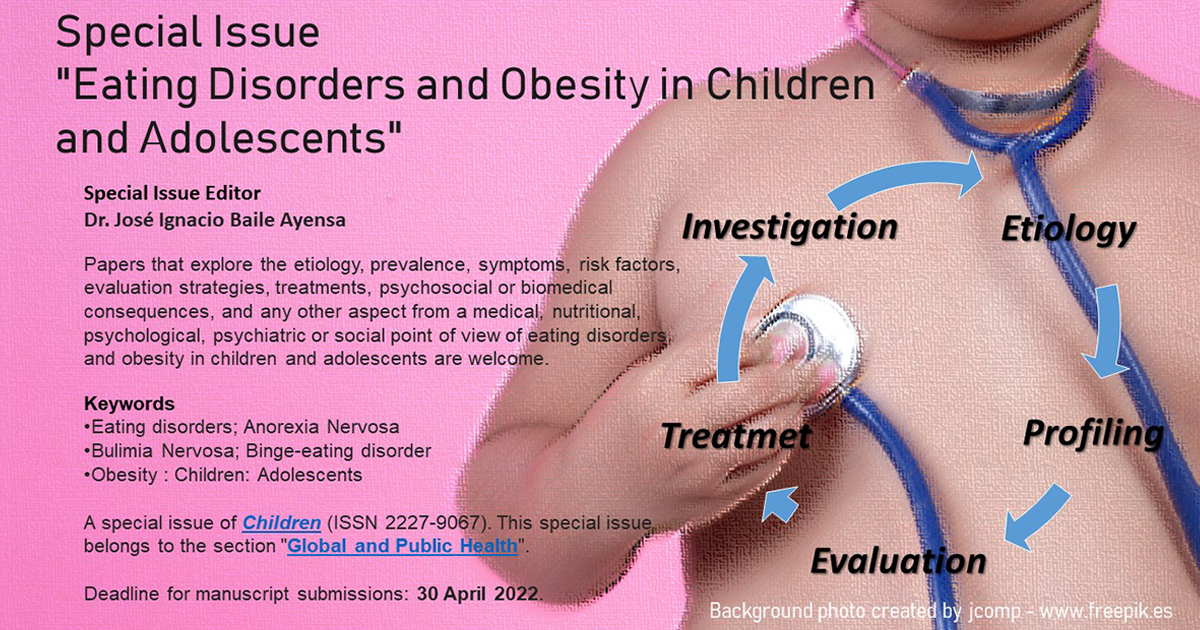- 2.1Impact Factor
- 3.8CiteScore
- 16 daysTime to First Decision
Eating Disorders and Obesity in Children and Adolescents
This special issue belongs to the section “Global Pediatric Health“.
Special Issue Information
Dear Colleagues,
Eating disorders continue to be one of the disorders with the highest prevalence among children and adolescents, especially in women. Anorexia Nervosa and Bulimia Nervosa are the main disorders at this stage of life. Binge-eating disorder is also highly prevalent, but mainly among adults. Eating disorders occur with significant comorbidity and are diseases that seriously alter the lives of children and adolescents who suffer from them, with important consequences for adult life. Mortality rates in patients with eating disorders are high and especially those with Anorexia Nervosa, especially among adolescent women. We need to broaden our knowledge of these disorders to reduce the impact among adolescents, either through preventive strategies or by improving treatments. The identification of risk factors or risk indicators has in recent years become a main objective in the investigation of these disorders.
In this Special Issue of Children, papers that explore the etiology, prevalence, symptoms, risk factors, evaluation strategies, treatments, psychosocial or biomedical consequences, and any other aspect from a medical, nutritional, psychological, psychiatric or social point of view of eating disorders in children and adolescents are welcome. The format of the papers may include original research, systematic literature reviews, narrative reviews, and case reports.
I look forward to receiving your contributions.
Dr. José Ignacio Baile Ayensa
Guest Editor
Manuscript Submission Information
Manuscripts should be submitted online at www.mdpi.com by registering and logging in to this website. Once you are registered, click here to go to the submission form. Manuscripts can be submitted until the deadline. All submissions that pass pre-check are peer-reviewed. Accepted papers will be published continuously in the journal (as soon as accepted) and will be listed together on the special issue website. Research articles, review articles as well as short communications are invited. For planned papers, a title and short abstract (about 250 words) can be sent to the Editorial Office for assessment.
Submitted manuscripts should not have been published previously, nor be under consideration for publication elsewhere (except conference proceedings papers). All manuscripts are thoroughly refereed through a single-blind peer-review process. A guide for authors and other relevant information for submission of manuscripts is available on the Instructions for Authors page. Children is an international peer-reviewed open access monthly journal published by MDPI.
Please visit the Instructions for Authors page before submitting a manuscript. The Article Processing Charge (APC) for publication in this open access journal is 2400 CHF (Swiss Francs). Submitted papers should be well formatted and use good English. Authors may use MDPI's English editing service prior to publication or during author revisions.
Keywords
- Eating disorders
- Anorexia Nervosa
- Bulimia Nervosa
- Binge-eating disorder
- Obesity
- Children
- Adolescents

Image courtesy of www.freepik.es
Benefits of Publishing in a Special Issue
- Ease of navigation: Grouping papers by topic helps scholars navigate broad scope journals more efficiently.
- Greater discoverability: Special Issues support the reach and impact of scientific research. Articles in Special Issues are more discoverable and cited more frequently.
- Expansion of research network: Special Issues facilitate connections among authors, fostering scientific collaborations.
- External promotion: Articles in Special Issues are often promoted through the journal's social media, increasing their visibility.
- e-Book format: Special Issues with more than 10 articles can be published as dedicated e-books, ensuring wide and rapid dissemination.

